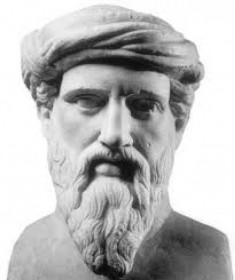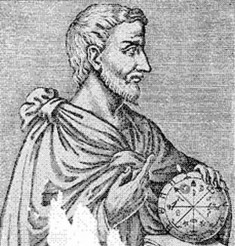| Pythagoras | |
|---|---|
 |
|
| Mathematician & philosopher | |
| Specialty | Metaphysics, music, politics, ethics |
| Born | c. 570 BC Samos |
| Died | c. 495 BC (around age 75) Metapontum |
| Nationality | Greek |
Pythagoras was a Greek philosopher known for many things. Among his accomplishments in life was the founding of the religion known as Pythagoreanism. The works of Pythagoras continue to influence and impact math and, in particular, geometry, to a great deal even well into the modern era. A brief look at his life reveals he was both a historically important and controversial figure.
The Life of Pythagoras
Pythagoras was born in Samos, Greece, near Turkey around 570 B.C. However, there are no clear and accurate records of the life of Pythagoras that exist. What does exist are biographical sketches crafted after his death. Many of his followers shrouded his life in secrecy and there are more than a few outright myths surrounding his life. One of the most outrageous noted that he was the son of the god, Apollo.
Based on the limited sketches we have, his father was Mnesarchus, a gem engraver and merchant. Pythagoras is believed to have eventually left Samos when he was about 40 years old during the reign of Polycrates. Throughout the course of his life, Pythagoras was able to study from Greeks, Egyptians, and various people in Asia. His formal education was in areas related to arithmetic, geometry, morals, astronomy, and religion.
Pythagoras was a sort of sojourner having traveled quite a bit of the world for the purpose of increasing his knowledge. Considering the vast array of knowledge he amassed in his life as evidenced by his teachings, his time traveling yielded great results.
Works of Pythagoras
It was Aristotle who said the Pythagoreans, the followers of Pythagoras, were the true fathers of mathematics. He also noted it was they who believed the notion that all things in life related back to mathematics.
One of the most troubling historical aspects about the life of Pythagoras is none of his original writings exist. They have all become lost to time and history. There are several forgeries that exist, but they are obviously not the primary texts to look towards to gain insight into his work. Secondary sources do reveal a great deal of information about his life’s work and within these sources is found  the incredible theorem named after him.
the incredible theorem named after him.
The Pythagorean theorem (a^2 + b^2 = c^2) is the masterwork attributed to Pythagoras. The theorem states that a right-angled triangle has an area on the side opposite the right angle (the hypotenuse) is equal to the complete sum of the squares of the other two sides.
Research shoes this theorem existed prior to Pythagoras and in cultures outside of Greece. However, it is Pythagoras who is credited with drawing the most attention to it and establishing it as a valid component to geometric thought. Ironically, the school of Pythagoras was one so rooted in secrecy, rumors exist that it may even have been one of his students who really came up with the theorem.
The very first mention of the connection between Pythagoras and his theorem are found in the writings of Cicero and Plutarch. These writings, however, did not appear until a full 500 years after the death of the Pythagoras. The origins of the development of the theorem may be forever lost, but Pythagoras does get all the credit surrounding it nonetheless.
The Religion of Pythagoreanism
Pythagoras established a strange metaphysical religion known as Pythagoreanism. The religion was influenced heavily by mathematics, astronomy, and even music. Eventually two different schools of thought emerged in this religion with one school being the learners and the other school being made up of the listeners. A key component to this religion and its two schools was the notion that mathematics was mystical, hence, appropriate as an influential basis for a religion.
Within this secretive religion was a symbol of the tetractys. The tetractys was a triangle figure made from four rows. The number 10 is arrived at when all the rows are added. The tetractys was an original invention of Pythagoras himself.
Last Years of Pythagoras
Later in his life, Pythagoras moved to Metapontum, Italy. He passed away around 495 B.C. According to legend, he did have a wife and children, though records about them are typically sketchy.